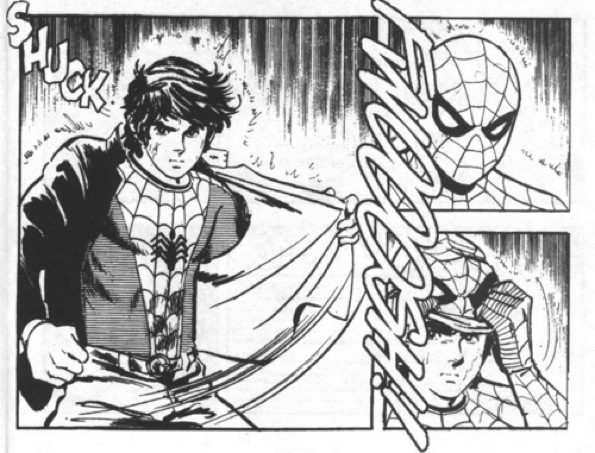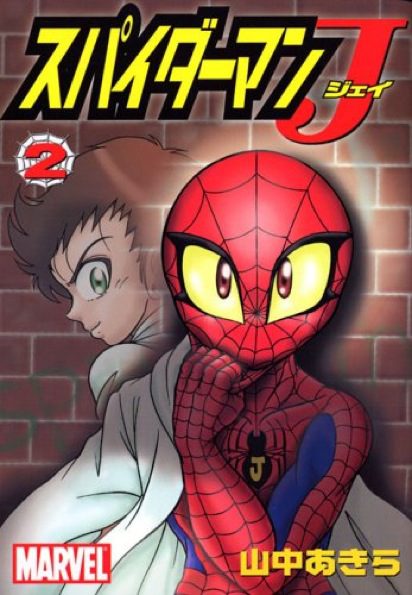I always find it funny when something becomes popular outside of its place of origin. Hell, people in the US have managed to make some anime so insanely popular when it was pretty darn average in Japan. So turnaround is fair play when it comes to Spider-Man. Marvel’s wallcrawler has a huge fan following in Japan, and it often resulted in very interesting and original interpretations.
Spider-Man: The Manga (1970 – 1971)

I remember collecting nearly every issue of the English translation of this rather bizarre entry in Spidey history. Initially written by Kosei Ono and drawn by Ryoichi Ikegami (who would later be famous for his art on the steamy action thriller manga Crying Freeman), this started off pretty much like a Japanese retelling of Spider-Man, although with a far more moody atmosphere. Junior high student Yu Komori, while conducting an experiment with radiation late at night at his school, gets bitten by an irradiated spider (when will science learn to not do open air radiation experiments?). He gets superpowers, but since he has no uncle to die and learn responsibility for his actions yet, he kinda just makes a costume and webshooters. His female pen pal comes to Tokyo looking for her lost brother, who came seeking work to pay for their mother’s operation. Yu decides to get a reward for a strange, super powered bank robber called Electro (yes, we’re going there), and goes after him as Spider-Man. The fledgling hero, however, ends up accidentally killing Electro (in reality the lost brother). And so Yu attempts to do what’s right with his powers while at the same time dealing with some truly dark stuff.
If you haven’t guessed, this is an odd one. The combination of a different culture and time period for its release makes it hard to truly accept this as Spidey. And yet Ikegami’s art often played with psychedelic, almost feverish nightmare imagery. This gave the manga a unique look and helped me remember the stories. For the first half or so, while Ono was the writer, it followed a formula of introducing Spidey foes, re-imagined as darker versions of themselves (my favorites being Lizard and Mysterio). Then, it got odd. Yu found himself in a story where he was accused being part of a group of rapists he helped fight off, and did not really appear in costume as he worked to clear his name. After the sixth storyline, writing duties switched to legendary Japanese sci-fi manga writer Kazumasa Hirai of 8-Man and Wolf Guy fame. When he took over, the quality of storytelling shifted up a notch, choosing instead of trying to adapt Spidey’s foes to Japan, to simply tell compelling stories about Yu and his own foes and issues. Of particular note are his encounter with the Winter Witch, a tragic woman based on a Japanese ghost story, and his friendship and conflict with a young man he gives blood to save and ends up becoming an evil Spider-Man. The sad thing is, Marvel cancelled their translation/release of this series, resulting in its last storyline never being completed in English. Poor sales due to uneven quality of the early half and the fact that Japanese comics shouldn’t have been broken down into such small chapters for a US monthly schedule means that a promising and impressive series will never be completed in America. Marvel, if you’re reading this, please re-release this series in time for Spider-Man’s 50th anniversary this year. I miss the adventures of Yu Komori.
Spider-Man the TV series (1978 – 1979)
youtube::3MxGtH-2duM::
This is probably the one Japanese Spider-Man most people have heard of. Toei, the Japanese company responsible for series like Kamen Rider and the Super Sentai shows (which are what Power Rangers was based on, by the way), created this show. In this series, the evil Iron Cross Army, led by Professor Monster (no, really) and his lieutenant Amazoness, played by Mitsuo Ando and Yukie Kagawa respectively, kill scientist Hiroshi Yamashiro. They then attempt to kill the professor’s oldest son Takuya, but he is saved by an alien from Planet Spider named Garia (no, REALLY). Garia, before dying, gives Takuya his Spider Braclet, and injects him with a liquid that gives him spider powers. With the Braclet and its web weapons, the classic red-and-blue suit now called the Spider Protector, the flying car Spider Machine GP-7 (NO, REALLY) and the giant spaceship Marveller which transforms into a giant robot called Leopardon (you get the point), Takuya fights to protect humanity and get revenge on Iron Cross for his father’s death.
Like most shows of this nature, there’d be a monster that would appear each episode, that would eventually turn into a giant. Spidey would then summon his robot and beat it. And yet, the show is not really as repetitive as you’d think. Each episode’s plot was unique, and it was pretty interesting. All I can say is, Marvel is officially streaming translated episodes on their site, so check it out if you can.
Spider-Man J

This one is odd. I’m still trying to find as much info as I can, since it’s had very little exposure in English. Sho Amano (changed to Peter Parker for the US release) is a 15 year old with spider powers, fighting against the evil Lord Gokibu (Beastius in the US). With his detective friend helping, Spider-Man J attempts to stop the villains and protect his friends and the city.
So, kinda a mixture of the live action show, with classic US Spidey. I’m planning to pick up the complete US release and give a better review in a later article.
This is one thing I do love about popular characters: seeing new interpretations of them by different creators. It’s both a compliment to the original work, and an inspiration to the rest of us to dream of new ways to tell stories of classic characters.
Still, I think we do owe the Japanese an apology for the American Godzilla film. So bring on more Japanese Spidey.




